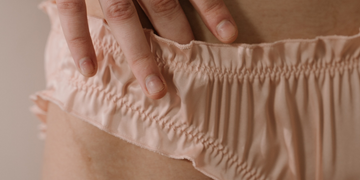Yeast infection myths

What causes yeast infections? We've heard everything — from hot tubs to sex. Some of these common myths have a basis in truth, to varying degrees. However, none of these explanations tell the whole story.
We’ll explore these common yeast infection myths in depth, take a look at suggested prevention methods, and consider how to handle yeast infections by looking at both prescribed and natural treatment options.
How do you get a yeast infection?
Yeast, bacteria, and other microorganisms make up the vaginal microbiome. When there’s too much yeast, you can get a yeast infection because your body has to compensate for the environmental imbalance. Understanding the variety of possible causes will help you recognize a yeast infection so you can take care of it.
Myth 1: Your menstrual cycle will cause a yeast infection
Hormonal changes that normally occur during the menstrual cycle may increase your risk of getting a yeast infection, but risk levels won’t change significantly with proper care. By changing sanitary products like tampons or pads more frequently, particularly in hotter weather, you can minimize this risk factor.
Myth 2: Having sex will cause a yeast infection
Yeast infections aren’t sexually transmitted diseases, even though partners can pass on yeast infections during sex if they have an untreated yeast infection. Having sex while you have a yeast infection isn’t recommended for a couple of other reasons as well. If you engage in sexual intercourse while on medication to treat a yeast infection (usually an antifungal), you may weaken the structural integrity of the condom. This can ultimately lead to contracting a yeast infection, or an increased risk of becoming pregnant. Sex can also aggravate yeast infection symptoms by further irritating your vagina.
Test and treat yeast infections
View this post on Instagram
Myth 3: Getting in a hot tub will cause a yeast infection
Since yeast thrives in warm and moist environments, there’s an assumption that sitting in a hot tub will lead to a yeast infection. Evidence for this claim isn’t conclusive, but we do know that yeast thrives and grows in moist environments, so it is a good idea to change out of wet clothing promptly.
Myth 4: Having your laptop directly in your lap will lead to yeast infection
There are several myths about yeast infections that originate because yeast thrives in warm, damp environments. The assumption that using your laptop in your lap will lead to yeast infection is one such example. But the evidence doesn’t suggest that this practice will make getting a yeast infection any more likely than usual.
vaginal-health-probiotic
Yeast infection prevention
Although avoidance tactics aren’t fail-proof, you can make some choices to reduce your risk of getting a yeast infection. Understanding the actual causes of yeast infection will better prepare you to recognize and treat the problem. The core cause of a yeast infection is the overgrowth of yeast. Many factors may lead to a yeast infection. The use of antibiotics, increased hormone levels, uncontrolled diabetes, and a weakened immune system increase risks.
Symptom recognition
If you think you have a yeast infection, we suggest visiting your primary care provider for a diagnosis. STIs and UTIs have similar symptoms to yeast infections, so it can be challenging to self-diagnose. Each type of infection needs to be treated differently and getting the wrong treatment can lead to further problems. You might be experiencing a yeast infection if you have:
- Thick, white discharge often compared to cottage cheese
- Watery discharge
- A vaginal rash or redness around the vulva
- An itchy and irritated vagina or vulva
- A burning sensation during sex or when you pee
Preventative measures to avoid yeast infection
Infections can’t always be avoided entirely, but some things may reduce your risk. Like with other types of infection, a strong immune system will help your body fight off a yeast infection. To stay healthy, pay attention to lifestyle decisions to do with diet, exercise, and sleep. Other practices associated with the prevention of yeast infection include:
- Avoiding scented hygiene products
- Wearing less restrictive underwear and pants
- Changing out of wet clothing promptly
- Wiping front to back when you use the toilet
- Changing sanitary products frequently during your period
Yeast infection treatments
The length of treatment depends on the severity of the yeast infection. For a minor-moderate case, treatment can be one to seven days. There are single-dose oral medications, vaginal suppositories, and topical antifungal medications. In more extreme cases, treatment can last for six months. You may be placed on multi-dose oral medications or long-course antifungal treatments in such cases.
Natural remedies
If you’re drawn to natural remedies it is extremely important that you consult your primary care provider. There’s not enough evidence to back up claims that the following myths will provide relief from yeast infection. Myths surrounding natural remedies for yeast infections include:
- Taking probiotics to rebalance your microbiome (will not cause you any harm, though this alone may not completely resolve a yeast infection.)
- Putting vinegar in your bath (this can increase vaginal irritation)
- Putting garlic in your vagina (don’t treat your vagina like your kitchen cabinet)
- Applying tea tree oil or coconut oil to your vagina
To handle any concerns and effectively manage your yeast infection, we suggest speaking with your primary care provider.
yeast-infection-complete-combo
Keep Reading

Can Your Mental Health F*ck With Your Vaginal Microbiome?
Apr 22

How the SAVE Act is impacting married women
Apr 2

I don't want to get pregnant under this administration, what do I do?
Mar 19









